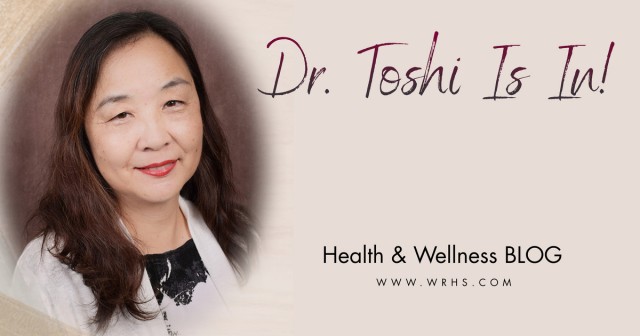Dr. Toshi Is In! "The difference between fats"
Dear Dr. Toshi,
Could you please explain the difference between unsaturated fat, monounsaturated fat, polyunsaturated fat, saturated fat, omega-3, and omega-6?
Wow, there are so many words related to the subject of fat, even after discussing "trans-fat" last week. And I haven't even talked about cholesterol or the "Lipid Panel" blood test yet! There is so much information about fat that I could talk about it for a whole week! I'll just talk about the basics today, but if you'd like to find more about this, you can check out the National Institute of Health website: https://ods.od.nih.gov.
The most important point in today's topic is this: when you eat fat, try to mainly eat "unsaturated fat." Don't try to eat a 100% "fat-free" diet because, first, it's impossible to do, and second, we actually need good kinds of fat (unsaturated fat) in our body.
Why is unsaturated fat so important? Well, it's because we need it for our bodies and bodily functions. It's part of our cell membranes and the coverings of our nerves (yes, our nerves have coverings!), and it plays roles in inflammation, blood clotting, moving our muscles, skin health, and many other things. Remember that we need blood clotting and inflammation. If we didn't have a mechanism to clot blood, we'd bleed to death any time we got a cut! And inflammation is an important part of our immune system that signals and fights invaders (pathogens like bacteria and viruses).
There are two kinds of unsaturated fat: MONOunsaturated and POLYunsaturated fat. Polyunsaturated fat includes omega-3 and omega-6, which you might have heard of. Omega-3 has been in the media a lot because many large studies show that it appears to protect us from many diseases, including some types of cancer, dementia, heart failure, and heart attacks. These studies are ongoing.
The three main types of omega-3 are ALA, DHA, and EPA. You might have seen these listed on the nutrition labels of certain products in stores, such as fish oil. You don't need to know what they stand for because they're tongue-twisters! The important thing to remember is that we need them but our bodies aren't good at making them. We need to eat them, so they're called "essential fatty acids" (fats). Our bodies can't make ALA at all. We can make a little DHA and EPA in our livers using ALA, so we have to eat foods that contain ALA. ALA is found in plant oils while DHA and EPA are mostly found in fish, and fish have a lot of DHA and EPA because of what they eat! (Fish eat plankton, and plankton eat algae, and algae are rich in ALA.) Some experts say that we eat enough omega-3 in a typical American diet, but people in Japan eat twice as much omega-3 than Americans, which could be one of the reasons why they have far fewer heart attacks.
Remember that unsaturated fat is a good kind of fat, and it's found in vegetables and other plant-based foods such as avocados, walnuts, vegetarian canned refried beans, kidney beans, and also in fish like salmon, sardines, and trout. The Institute of Medicine recommends that we should replace saturated fat and trans-fat with monounsaturated fat or polyunsaturated fat as much as possible. When it comes to cooking oil, monounsaturated fat can be found in olive oil, while polyunsaturated fat is in canola oil, sunflower oil, safflower oil, flaxseed oil, and soybean oil.
Finally, let's talk about saturated fat. Saturated fats are found in red meat, whole milk, whole-milk dairy products (think foods like cheese, sour cream and cottage cheese), coconut oil (80-90% of coconut oil is saturated fat), and many commercially baked goods. Saturated fats increase bad cholesterol (LDL) but also increase good cholesterol (HDL) a little too, so they're not considered as bad as trans-fat we talked about last week. Saturated fats are solid at room temperature, just like trans-fat. The American Heart Association recommends replacing saturated fats with unsaturated fats and limiting the amount of saturated fat you eat. You might be wondering how you can limit saturated fat, and that's a good question. Health experts recommend eating lean meat and skinless poultry and use oil-based products rather than butter, margarine, etc. which are solid at room temperature.
And the health experts also always add this point: make sure you don't just replace fat with unhealthy foods that contain a lot of simple carbohydrates. Examples of those are sugar, juice, store-bought BBQ sauce, candies, and white bread.
These are a lot of recommendations! So, I'd recommend starting out with this: eat many different kinds of healthy fruit and vegetables, use fat-free or low-fat (1%) milk products, avoid trans-fats at all cost, and try to limit deep-fried foods, animal-derived fats such as red meat, whole milk dairy products, and poultry that still has the skin and fat on it. What we eat today will make a difference in our health tomorrow!
By the way, this has nothing to do with your diet, but please make sure you get a flu shot if you haven't gotten one yet! It's especially important this year with Covid-19 going around!
Dr. Toshiko (Toshi) Luckow, MD is a Family Medicine physician at the West River Health Services hospital and clinics.
When you subscribe to the blog, we will send you an e-mail when there are new updates on the site so you wouldn't miss them.


Comments